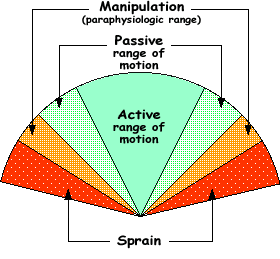Spinal Manipulation, it's not the "pop/crack" but the movement of the joint and its surrounding capsule that provides the physical benefit!
Chiropractors are famed for their “Cracking and Popping” of joints (we’ve all seen the online videos!). But what is this cracking noise, and how is it beneficial?
We’ve put together some information to explain both the noise, and its place within treatment. “You shouldn’t crack your knuckles! You’ll get Arthritis!” – said everyone’s Nan, ever! Don't worry this has been disproven as a myth. So what happens within your joints when they crack? First of all, you need to know the basic anatomy of a joint: A Synovial joint is made up of the ends of 2 bones, which are connected by a joint capsule (picture pushing two fingers into either end of an inflated balloon). The joint capsule is filled with synovial fluid (a fluid within the balloon) – which keeps the joint moving fluidly and free from friction.
During an Adjustment, or Spinal Manipulation, a stretch is put through this joint, and causes the surfaces of the two bones to be pulled apart from each other.
This causes a decrease in pressure within the joint.
Very small bubbles within the synovial fluid coalesce during this period of low pressure (when the joint is “on stretch”) to form one large “bubble” or vacuum.
When a HVLA (High Velocity, Low Amplitude) thrust/impulse is applied to the joint the larger “bubble/vacuum” collapses within the fluid and returns to smaller bubbles.
It’s this collapsing, or “imploding” of this larger bubble (back into lots of smaller bubbles) that causes the recognisable cracking and popping.
This process is known as Cavitation.
Here is a video demonstrating joint cavitation in real time.
Simple – right? But why is this beneficial? The honest answer? The audible popping sound has NO proven physiological effect, purpose or benefit to treatment, it is merely a side effect of spinal manipulation. Risky for a Chiropractor to say? Maybe – but let us tell you more!
“There is no direct evidence for the physiological therapeutic benefit of the audible release associated with the chiropractic adjustment.” - Mischa Bakker, Joyce Miller. J Can Chiropr Assoc. 2004 Many patients come to us and say, “I just need to have my back clicked”. The reality is – they don’t need it "clicked", they mean they need an adjustment.
There is a lot of emphasis put on this audible cracking or popping noise because let's be honest, it's a very satisfying almost therapeutic sound to many people. Ultimately – it doesn’t matter whether your joints make a loud noise, a little noise, or no noise whatsoever during an adjustment. The aim of manipulating a joint is to take the joint's

range of motion into what we call the “Para-physiological range”. Essentially – the aim is to increase the range of motion of the joint we are treating/manipulating. The diagram here shows the difference in how much any joint moves in different scenarios (ROM – Range of Motion). Active ROM: the amount the joint moves when used during day to activity. Passive ROM: the amount the joint moves when relaxed and moved by someone else (i.e. your chiropractor). The para-physiological range is the most a joint will move without injury, and we take the joint to this point via Manipulation. The audible popping sound sometimes occurs with these manipulations, and sometimes doesn’t. But really – it doesn’t matter. From a treatment and benefit stand point – so long as the joint ROM exceeds that of its Passive ROM – we’ve achieved our goal.Pop or no pop! So don’t worry, this isn’t us just trying to explain away why some people/some joints click and some don’t -
…. However There have been studies that show: there may be some benefit to the audible popping sound. These studies suggest that whilst there is no physiological effect linked with the noise, it may be beneficial in other ways:
“Possibly the greatest therapeutic benefit of the audible release (popping) may not be physiological in nature, but rather psychological… an audible release (popping) may improve the outcome or a Chiropractic adjustment, but therapeutic benefits of the audible release (popping) are likely to be psychological and physiological.” - Mischa Bakker, Joyce Miller. J Can Chiropr Assoc. 2004
So, the bottom line? A popping, clicking or cracking noise doesn’t make any difference to the joint being treated – only to the way you perceive or interpret it but it might make you feel better.
